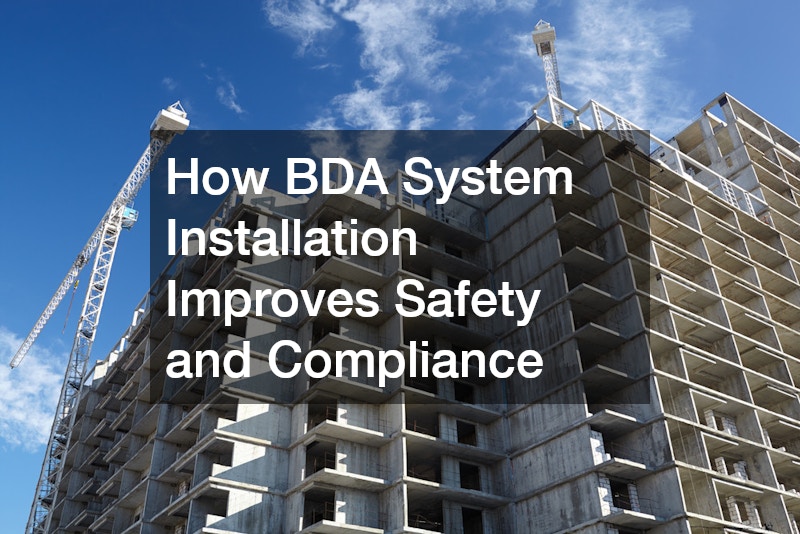In this article, we will explore the importance of Building Distributed Antenna Systems (BDA) in enhancing safety protocols and ensuring compliance with regulatory standards. These systems are increasingly becoming indispensable in today’s urban planning and safety protocols. As buildings grow taller and more complex, effective BDA system installation must guarantee the safety of occupants and first responders alike.
Understanding the nuances of BDA systems is critical, especially when considering the implications they have on emergency scenarios. Many stakeholders—including building owners, facility managers, and emergency services—need to appreciate how BDAs function to ensure that safety protocols are up to date.
Moreover, as regulatory standards evolve, so too must the systems that support them, especially for public safety communications.
We will address common questions and concerns regarding BDA systems and their installation, setting the stage for a deeper discussion on the role of these systems in emergency situations, regulatory compliance, and their broader benefits. The intention of this article is to provide clarity on an often-overlooked but crucial element of building safety technology.
What is a BDA System and How Does it Work?
A Building Distributed Antenna (BDA) System is designed to enhance cellular signal coverage within structures that may not receive adequate communication signals due to their design or location. These systems consist of various components, including antennas, amplifiers, and the cabling required to distribute signals effectively throughout a building. The architecture of a BDA allows it to capture signals from external sources and amplify them for internal use, ensuring no dead zones exist where communication is hindered.
The technology behind BDA systems relies on a combination of passive and active components, which work together to relay signals with optimal strength and clarity. Passive components include cables and antennas that do not require external power, while active components like amplifiers are essential for boosting signal strength. This synergistic operation allows BDAs to provide reliable communication channels that are essential during emergencies, ensuring that everyone within the building can connect to emergency services if needed.
How Does BDA Installation Ensure Communication During Emergencies?
The installation of BDA systems significantly enhances communication capabilities during emergencies, which is paramount for both occupants and first responders. In a crisis, immediate access to reliable communication can be the difference between life and death. BDA systems ensure that not only emergency services can communicate effectively but also that the people within the building are informed and can respond accordingly during different types of emergencies, such as fires, medical crises, or security threats.
By providing a consistent and strong cellular signal, BDAs help to overcome barriers that commonly disrupt communication, such as thick walls or multi-story configurations. This reliability is critical during emergencies when time is of the essence. The system can seamlessly connect first responders to their respective dispatch units, allowing for quicker responses and assistance. All lines of communication remain open, ensuring that every individual involved can receive real-time updates and instruction.
What Are the Regulatory Compliance Standards for BDA Systems?
Regulatory compliance for BDA systems is an essential aspect for many buildings, particularly those in urban areas where regulations may be more stringent. Local and national codes often dictate the installation of BDA systems, especially in high-rise buildings, hospitals, schools, and other public venues. Compliance ensures that these structures can support first responders in their efforts to maintain safety and security during emergencies.
Specific regulations, such as those outlined by the National Fire Protection Association (NFPA) and the International Fire Code (IFC), mandate that buildings must have adequate communication capabilities for emergency responders. These regulations not only focus on the installation of BDA systems but also specify testing and maintenance protocols to ensure that they remain functional when needed most. Understanding these legal requirements is crucial for property developers, managers, and safety officers.
Adhering to regulatory standards doesn’t just serve legal purposes; it enhances the overall safety culture within a building. Compliance can lead to incentives, including lower insurance premiums and greater peace of mind for tenants and employees. Consequently, the proactive installation of BDA systems elevates the commitment to safety and preparedness, fostering an environment where communication and collaboration thrive in emergencies.
What Benefits Do BDA Systems Provide Beyond Compliance?
BDA systems contribute to a better user experience not only for employees but also for guests within a facility. Reliable communication enhances productivity, allowing teams to collaborate seamlessly without worrying about connectivity issues. Furthermore, the presence of BDA systems can also elevate the overall value of a property, making it more attractive to prospective tenants or buyers who prioritize safety and technology.
Ultimately, BDAs also contribute to a culture of safety that extends beyond mere compliance with regulations. For stakeholders, investing in these systems reflects a commitment to safeguarding lives and ensuring that all individuals can communicate effectively during emergencies. As awareness of safety protocols grows, so too does the demand for enhancements in building infrastructure, including the installation of BDA systems that serve a multifaceted purpose in safety and compliance.
In summary, the installation of BDA systems significantly enhances safety and compliance within various environments. The importance of robust communication channels during emergencies cannot be overstated, and BDAs provide a critical infrastructure component that ensures seamless connectivity. Understanding their function and benefits is crucial for stakeholders involved in building management and emergency response planning, highlighting the significant role these systems play in safeguarding lives and property.

